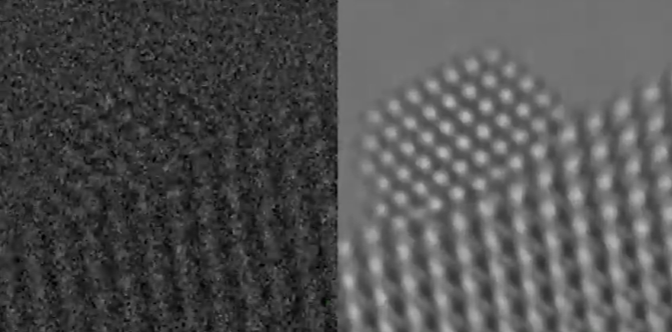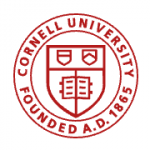
ΑΙhub.org
Visualizing nanoparticle dynamics using AI-based method
 Static image taken from video (shown below). Left: a platinum nanoparticle imaged via electron microscopy. Right: using AI-based method to remove the noise.
Static image taken from video (shown below). Left: a platinum nanoparticle imaged via electron microscopy. Right: using AI-based method to remove the noise.
By Patricia Waldron
A team of scientists has developed a method to illuminate the dynamic behavior of nanoparticles. The work, reported in Visualizing Nanoparticle Surface Dynamics and Instabilities Enabled by Deep Denoising, in the journal Science, combines artificial intelligence with electron microscopy to render visuals of how these tiny bits of matter respond to stimuli.
“The nature of changes in the particle is exceptionally diverse, including fluxional periods, manifesting as rapid changes in atomic structure, particle shape, and orientation; understanding these dynamics requires new statistical tools,” said David S. Matteson (Cornell University), one of the paper’s authors. “This study introduces a new statistic that utilizes topological data analysis to both quantify fluxionality and to track the stability of particles as they transition between ordered and disordered states.”
On the left, a platinum nanoparticle imaged via electron microscopy displays individual atoms but is heavily corrupted by noise. The image on the right shows the results of an AI system that effectively removes the noise to reveal the atomic structure of the nanoparticle.
The work, which also included researchers from New York University, Arizona State University and the University of Iowa, blends electron microscopy with AI to enable scientists to see the structures and movements of molecules that are one-billionth of a meter in size at an unprecedented time resolution.
“Nanoparticle-based catalytic systems have a tremendous impact on society,” said co-author Carlos Fernandez-Granda (NYU). “It is estimated that 90 percent of all manufactured products involve catalytic processes somewhere in their production chain. We have developed an artificial-intelligence method that opens a new window for the exploration of atomic-level structural dynamics in materials.”
Observing the movement of atoms on a nanoparticle is crucial to understand functionality in industrial applications. The problem is that the atoms are barely visible in the data, so scientists cannot be sure how they are behaving—the equivalent of tracking objects in a video taken at night with an old camera. To address this challenge, the paper’s authors trained a deep neural network that is able to “light up” the electron-microscope images, revealing the underlying atoms and their dynamic behavior.
“Electron microscopy can capture images at a high spatial resolution, but because of the velocity at which the atomic structure of nanoparticles changes during chemical reactions, we need to gather data at a very high speed to understand their functionality,” said co-author Peter A. Crozier (Arizona State University).
“This results in extremely noisy measurements. We have developed an artificial-intelligence method that learns how to remove this noise—automatically—enabling the visualization of key atomic-level dynamics.”
The research was supported by grants from the National Science Foundation.
tags: quick read








